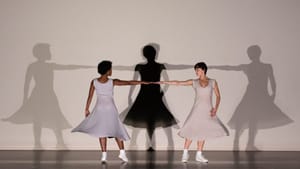Stay in the Loop
BSR publishes on a weekly schedule, with an email newsletter every Wednesday and Thursday morning. There’s no paywall, and subscribing is always free.
An infallible collision
Philly Fringe 2019: FringeArts presents ‘FASE, Four Movements to the Music of Steve Reich’

Listening to recordings of Steve Reich’s early experimentation with repetitive music can be torturous, but when the intricately disjointed phasing is illustrated with absolute precision by Anne Teresa de Keersmaeker’s choreography, as in the curated Fringe offering FASE, the musical ideas become clear and meaningful.
Steve Reich discovered phase music by accident. He was listening to music on two different tape recorders which were slightly out of kilter. This inspired him to compose music in out-of-sync phases. For listeners, this can be stressful—unless they are sophisticated enough to hear the slowly shifting sonic landscape.
What the music is doing
Belgian choreographer De Keersmaeker was always able to hear what the music was doing. She illustrates the shifts with her intrepid choreography of four of Reich’s pieces in FASE.
Piano Phase (1967) uses lights to project the two dancers’ silhouettes onto the back of the stage individually and merged—varying as they move in and out of phase. The dancers, Laura Bachman and Soa Ratsifandrihana, twirl and step at varied speeds while their double silhouette pulls apart and comes back together. The movements and variations were so subtle that the entire 20 minutes of the piece flew by.
Drawing blood
Come out (1966) is a processed version of a single sentence from an interview with David Hamm, who was beaten after being taken into custody during the Harlem riots of 1964. The detained youths who were bleeding were the only ones who received medical treatment. The audience hears Hamm say clearly, “I had to, like, open the bruise up to let some of the bruise blood come out to show them.” The words become distorted as they are looped electronically while the two dancers, dressed in street clothes, sit on stools under hanging lamps, turning and tossing their arms and touching their necks. The dancers move faster and faster, coming dangerously close to hitting each other with their frenetic movements.
Music, dance, and rhythm
The solo dance to the music Violin Phase (1967) was the least exciting in terms of choreography because there was no second dancer to show the phases going in and out of sync.
Clapping Music (1972) is a recording of two performers clapping in shifting patterns of 12 eighth notes. The dancers were infallible in their abrupt movements, in and out of sync, always within a hair’s breadth of collision, turning and shifting in the nick of time.
De Keersmaeker’s choreography and lighting and the fantastically disciplined, accurate, and inexhaustible dancing by Bachman and Ratsifandrihana provided an insight into Steve Reich’s music that could not be more vivid. This show has expanded my view of music, dance, and rhythm beyond my expectation.
What, When, Where
FASE, Four Movements to the Music of Steve Reich by Anne Teresa De Keersmaeker/ROSAS: Piano Phase (1967), Come Out (1966), Violin Phase (1967), and Clapping Music (1972). Through September 14 at FringeArts, 140 N Columbus Boulevard, Philadelphia. (215) 413-1318 or fringearts.com.
FringeArts is a wheelchair-accessible venue. For information on all accessibility features, visit here, call the box office, or email [email protected]. There is a private gender-neutral restroom available on the second floor.
Sign up for our newsletter
All of the week's new articles, all in one place. Sign up for the free weekly BSR newsletters, and don't miss a conversation.

 Margaret Darby
Margaret Darby